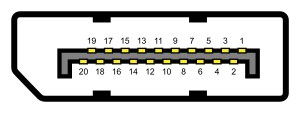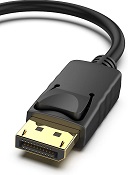What is DisplayPort?
Displayport 1.0 was released in May of 2006 and was introduced as a replacement for outdated connectors such as DVI, VGA, FPD-Link, LVDS etc. Soon after its release Displayport began the journey to becoming the industrial standard and nowadays it is built into almost every chipset, GPU and controllers manufactured by every major silicon manufacturers. Just like any other connector the main use of the Displayport is to link a display and a video source, however its functionality doesn’t end there, it is also capable of transmitting audio and other various forms of data. The good news is that Displayport is backwards compatible with other connectors such as USB, HDMI, VAG, DVI etc (although an adapter would be required).
A Displayport cable is capable of supporting a minimum of FHD (1080p) resolution @ 60Hz.
Displayport is the first display interface to make use of packetized data transmission (such technology is used in USB and PCI Express). Packetized data transmission makes use of small data packets called micro packets which are capable of embedding clock signals in the data streams, which allows fewer pins to be used for a higher resolution. Using data packets also makes the Displayport quite extensible, which means that more features can be easily added without having to make any significant alterations to the shape of the interface.
A Displayport cable has a total of 20 pins, as shown below (the image was taken from Wikipedia.org)

Displayport Versions
- 1.0 (2006)
- 1.1 (2007)
- 1.1a (2008)
- 1.2 (2010)
- 1.2a (2012)
- 1.3 (2014)
- 1.4 (2016)
- 1.4a (2018)
- 2.0 (2019)
All Displayport cables offer the same features, the difference is in the transfer speed. How much data you transmit via your Displayport cable affects the refresh rate, color depth, resolution and the number of monitors you can daisy chain.
Each update brought with itself the ability to achieve higher data transfer speeds and resolution, the following table summarizes the changes in speed and supported resolution.
| Version | Resolution | Maximum Transfer Rate |
| 1.0 | 1440p @60Hz | 8.6 Gbps |
| 1.1 | 1440p @60HZ | 8.6 Gbps |
| 1.2 | 4K @60Hz | 17.3 Gbps |
| 1.3 | 4K @120Hz 8K @60Hz | 26 Gbps |
| 1.4 | 4K @120Hz 8K @60Hz | 26 Gbps |
| 1.4a | 4K @120Hz 8K @60Hz | 26 Gbps |
| 2.0 | 8K @60Hz | 80 Gbps |
Active and Passive Cables
Passive Displayport cables aren’t usually longer than 33 feet long, which is due to the fact that the longer the cable gets, the more distance the signal has to travel, which causes the signal to weaken and more likely to endure errors and interference. Same is the case if you are transferring heavy data (such as a video with a high resolution).
Fortunately if you need a longer cable then there are two options, Active or a Signal booster cable. Both of them carry out, essentially, the same task (which is transmitting signals). Both of them strengthen signals so that it can travel further, which is why active or signal boosting cables can reach a length of 150 feet or more.
Displayport v2.0
Single Display
· 1x 15360x8640p (16K) @ 60Hz with 30 bits per pixel (bit/px) HDR
· 1x 10240x4320p (10K) @ 60Hz with 24 bits per pixel SDR
Dual Display
· 2x 7680x4320p (8K) @ 120Hz with 30 bits per pixel HDR
· 2x 3840x2160p (4K) @ 144Hz with 24 bits per pixel SDR
Triple Display
· 3x 10240x4320p (10K) @ 60Hz with 30 bits per pixel HDR
· 3x 3840x2160p (4K) @ 90Hz with 30 bits per pixel HDR
Displayport 2.0 introduced a new transmission mode, called the Ultra High Bit Rate, which offers three bandwidth options, 10, 13.5 and 20 Gbps. The maximum bandwidth of a 4 lane connector would be (20Gbps x 4) 80Gbps.
Mini Displayport
Mini Displayport was introduced by Apple in 2008, to serve as a compact version of the original Displayport. It offered the same specs as Displayport v1.2, a 4 lane connector capable of transmitting 5.4 Gbps per lane (which totals up to 21.6 Gbps on all 4 lanes). The Mini Displayport can be connected with a regular Displayport via a passive adapter.

